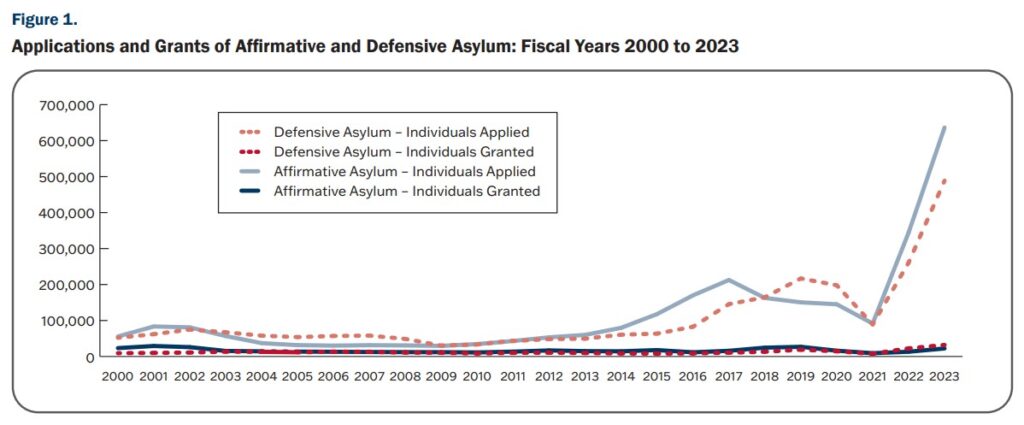By Michael Capuano
FAIR
A brand-new report published by the Department of Homeland Security (DHS) shows that the United States asylum system is bursting at the seams. Last year, the U.S. experienced the highest number of filings ever. A whopping 945,370 new asylum cases were filed in FY 2023—a 520 percent increase since FY 2021. Of these, 456,750 cases were filed with USCIS (referred to as affirmative asylum) and 488,620 were filed in immigration court (referred to as defensive asylum). While the number of asylum cases has hit historic levels, the applications actually cover hundreds of thousands of additional migrants who are spouses and dependents of the primary asylum applicant.

Source: Department of Homeland Security, Office of Homeland Security Statistics, 2024.
The U.S. operates an extremely generous humanitarian immigration system, which offers protection to asylees and refugees. The difference between the two is mainly geographical. Asylum-seekers are individuals already in the U.S. who ask for protection from persecution in their home countries. Refugees are individuals living outside the U.S. who seek protection in the U.S. (or another country) from persecution in their home countries. There is no numerical limit to the number of asylees the U.S. accepts each year. On top of that, the President, in his discretion, sets the number of refugees the U.S. will admit each year. That number of refugees may be increased even after it is set.
Our system is so generous that it is being overwhelmed to the brink of collapse. The asylum program has been hardest hit. It was designed to handle small numbers of people genuinely fleeing persecution, not large waves of economic migrants. But by adopting catch-and-release policies, including the illegal use of parole, the Biden-Harris administration has encouraged migrants from all over the world to come to our borders and claim asylum, whether they have a credible claim or not.
The massive wave of illegal immigration caused by the administration’s immigration policies is now overwhelming our asylum system, to the point that it is on the brink of collapse. The backlog of asylum cases in the United States surpassed 2 million cases by the end of 2023, 1.1 million of which are in immigration court, and another one million are pending at USCIS. Now, some immigration courts are setting court dates well into the 2030s for newly arrived illegal aliens. Sadly, the likelihood that someone facing genuine persecution will receive meaningful attention under these circumstances is slim to none.
These delays, combined with the Biden-Harris administration’s policy to release virtually all illegal aliens, have further encouraged economic migrants to take advantage of our asylum program. Once an application for asylum is filed, illegal aliens are protected from deportation and can work legally while their case is processed. The administration has even extended the validity of work permits for asylum applicants from 2 to 5 years, claiming the change was needed because of delays that their own policies created. This only makes filing a fraudulent application more appealing to economic migrants, and undermines the humanitarian intent of the asylum. Instead of cracking down on the well-documented issue of asylum fraud and the border crisis that lets illegal aliens in the first place, Biden-Harris administration policies are making the crisis worse.
On top of the historic demands being placed on our asylum system, President Biden wants to maintain a high influx of refugees. On Monday, President Biden announced that the U.S. would agree to resettle up to 125,000 refugees in FY 2025, maintaining the administration’s high target for yet another year. The Biden-Harris administration has maintained a refugee target of 125,000 each year since 2022, the highest target since 1992 (142,000). From 2000 to 2016, the target was generally around 70-80,000 per year, and the previous administration substantially reduced it to a low of 18,000 in 2020.
The Biden-Harris administration is working hard to meet the target too. It resettled over 100,000 refugees in FY 2024 alone—the highest number of refugees resettled in 30 years. However, from 2001 to 2012, the actual number of resettlements was well below the target. During President Obama’s second term and President Trump’s four years in office, the targets were usually met, although they were much lower. Even in FY 2022, the Biden-Harris administration only resettled 25,000 refugees of the 125,000 target, as many State Department resources were directed to parole programs for Ukrainians and Afghans.
The Biden-Harris administration has also changed its refugee policies to make it easier to bring in these refugees. Normally, refugees are nominated by the United Nations High Commissioner for Refugees (UNHCR) and then referred to countries that agree to take them. While not a perfect system, this cuts down on abuses related to family ties in the U.S. and undue diaspora influence. The Biden-Harris administration, however, has introduced a program that completely undercuts these safeguards. The “Welcome Corps” program created at the end of 2023 allows groups of American citizens or permanent residents to directly choose which refugees they want to bring. The requirements and safeguards are minimal, and sponsors are only required to offer $2,500 per refugee to be accepted. This immediately privileges individuals with connections in the U.S., rather than those most in need, and makes a mockery of the humanitarian intent of refugee resettlement.
The U.S. already resettles a highly disproportionate number of refugees compared to other countries. The U.S. took in almost two-thirds of the 96,311 UNHCR refugees resettled in 2023, totaling 61,644, even though we only have four percent of the world’s population. In fact, the U.S. is doing far more than our fair share while many large and stable countries like India, Thailand, Malaysia, and Indonesia are not even parties to the treaty that created the UN refugee system. Furthermore, UNHCR data show that only 46 countries have resettled any refugees at all since 2003, and the vast majority of those refugees still went to the U.S. and Canada. Other countries, particularly those in troubled regions where persecuted individuals are seeking international protection, must do their part as well.
In many cases, avenues other than resettlement are more cost-effective and better for the host country. One study published by the Center for Immigration Studies found that the cost of resettling one refugee in the U.S. for five years could pay for 12 refugees to be protected and provided for in their country of origin. Humanitarian programs are not cost-oriented, but the costs are still real for the government and for communities that take in refugees. Unfortunately, the biggest beneficiaries of our spending are not refugees themselves, but NGOs and other groups who are paid to sponsor more people.
The data increasingly show that the policies of the Biden-Harris administration have placed an unsustainable burden on America’s humanitarian immigration programs. Asylum has transformed from a last-resort option for those genuinely in danger to an overloaded and fraud-ridden work-permit scheme for economic migrants. Rather than stopping asylum fraud, the administration’s policies incentivize it. Adopting real policy reforms to our asylum system and stabilizing the border must be prioritized if we want to save these programs from utter collapse.
















